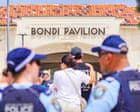
Frydenberg claims Albanese should accept ‘personal responsibility’ for Bondi attacks in escalation of rhetoric
PM condemns ‘perversion of Islam’ that police allege may be behind the attack
Stay updated with the latest insights, tutorials, and trends in technology

PM condemns ‘perversion of Islam’ that police allege may be behind the attack

Josh Frydenberg says three police patrolling the event were ‘ill-equipped’ to protect citizens, but NSW premier again defends response

Avner’s Bakery told customers that ‘it is no longer possible to make outwardly, publicly, proudly Jewish places and events safe in Australia’

Follow today’s news liveFull report:

Move comes amid escalating campaign against Maduro as Venezuelan government condemns ‘grotesque threat’Donald Trump has ordered “a total and...

Welcome to the Fox News Politics newsletter, with the latest updates on the Trump administration, Capitol Hill and more Fox News politics content....

Once a safe cushion for Democrats, North Carolina’s registration gap has shrunk since 2015, leaving the parties nearly tied as both sides battle for...

Trump orders total Venezuela oil blockade, designates Maduro regime as foreign terrorist organization over stolen U.S. assets and criminal...

The Department of Health and Human Services launches review of Minnesota s use of $8.6 billion in federal social service funding under Gov. Tim Walz...

Operation Midway Blitz intensifies as Border Patrol deploys additional agents to Chicago despite local officials opposition to federal immigration...

Google says the reports lacked "helpful next steps." ...

Government seeks "nudity-detection algorithms" in iOS and Android, report says. ...
Showing page 1 of 2018 (24209 total articles)